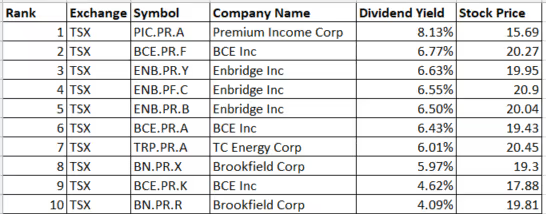When most investors think of fixed income, government or corporate bonds usually come to mind. Yet, tucked away in the Canadian market is an asset class that quietly delivers high yields, tax advantages, and diversification: Canadian preferred shares. Despite their long history and unique benefits, preferred shares remain underappreciated by many investors. Here’s why they deserve a closer look.
Preferred shares are a type of hybrid security, blending characteristics of both stocks and bonds. Like bonds, they pay a regular income, typically in the form of fixed or floating dividends, and these dividends are usually calculated as a percentage of the share’s standard $25 par value which is the typical price at which most Canadian preferred shares are issued and can be redeemed by the issuer. Unlike bonds, most preferreds don’t have a maturity date, and unlike common stocks, they usually don’t come with voting rights. However, preferred shareholders enjoy priority over common shareholders when it comes to dividends and, in the event of bankruptcy, asset distribution. The $25 par value also serves as the reference point for dividend payments and redemption, anchoring both the income investors receive and the price at which issuers may buy back the shares, typically after a set period such as five years.
Canadian preferred shares currently offer some of the highest yields in the fixed income space. Many issues yield in the mid-5% range or higher, making them especially appealing in today’s environment of moderate bond yields and low savings rates. For income-focused investors, this can mean a significant boost to portfolio returns.
One of the standout features of Canadian preferred shares is the tax treatment of their dividends. Unlike interest from bonds, dividends from Canadian preferreds are eligible for the dividend tax credit, making after-tax returns much more attractive, particularly for Canadian investors in higher tax brackets.
Most Canadian preferred shares are issued by blue-chip companies, such as the country’s major banks, utilities, and large corporations. This means investors are typically exposed to issuers with strong credit profiles and a long history of reliable dividend payments.
Preferred shares behave differently from both common stocks and bonds. Their unique risk-return profile provides an additional layer of diversification, helping to smooth out portfolio volatility and reduce overall risk.
Certain types of preferred shares, notably rate-reset and floating-rate issues, offer some protection against rising interest rates. Their dividends adjust periodically based on prevailing rates, helping to preserve income and reduce interest rate risk.
Rate-reset preferred shares are designed to adjust their dividends periodically (usually every five years) based on a benchmark interest rate, such as the Government of Canada 5-year bond yield. When rates rise, the dividend paid by these shares typically increases at reset, helping to support or even boost their prices. This feature gives them lower sensitivity to interest rate risk compared to traditional bonds or perpetual preferred shares.
Floating-rate preferred shares (a smaller segment of the market) also benefit directly from rising rates, as their dividends move in tandem with prevailing interest rates.
Rate-reset preferreds can see their dividends decrease at the next reset if benchmark rates fall, which may put downward pressure on their prices. However, some rate-reset preferreds include a minimum rate feature, which can limit the downside for investors by guaranteeing a minimum dividend, even if rates drop significantly.
Overall, preferred shares, especially those without minimum reset rates, can underperform in a sharply falling rate environment, but those with minimums offer more stability.
Of course, no investment is without risk. Preferred shares can be sensitive to changes in interest rates and credit conditions. They also tend to be less liquid than common stocks or government bonds, and their price can fluctuate with market sentiment. It’s important for investors to understand these risks and consider how preferreds fit within their broader investment strategy.
Investors can purchase individual preferred shares directly with an online broker as they trade just like any stock, investors can also gain exposure through ETFs and mutual funds that specialize in this asset class making them a practical option for those new to preferreds or seeking a hands-off approach.
Canadian preferred shares offer a compelling combination of high yields, tax efficiency, and diversification, qualities that are increasingly hard to find in today’s fixed income landscape. For investors willing to look beyond traditional bonds, preferred shares may be the hidden gem that adds both income and stability to a well-rounded portfolio.
You can easily search for Canadian preferred shares using trading Central’s Strategy Builder tool, (available at most Canadian online broker platforms) which allows you to filter and compare preferred shares based on a range of criteria. This tool provides an overall view of the preferred share market, making it simple to locate and analyze the best options within a specific sector or across the entire market. With just a few clicks, you can build a customized list of preferred shares that fit your strategy, helping you make more informed and targeted investment decisions.

Below is a list of Canadian preferred shares screened using Trading Central Strategy Builder. The focus was on preferred shares trading below $21/share and have an indicated yield of at least 4%.
